Hot Stove
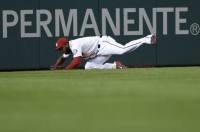
The free agent market is thin, but there are players out there who could help the Mets. One player who is out there that will not help the Mets is Denard Span.
Look, Span can still handle the bat. The last two years were his best in terms of OBP. These past two years, he’s had two of his three best batting average and slugging percentage seasons. You know what else happened over the past two years:
- He got older;
- He’s become injury prone; and
- He can’t play CF anymore.
Over the past year, he’s had three surgeries. The last one was to fix a torn labrum in his hip. Span will require 4-6 months of rehab meaning he won’t be ready to resume baseball activities until March. He will be 32 going on 40 to begin the 2016 season. He’s predicted to receive a 3 year $36 million deal in free agency.
Putting his injuries aside, he’s not worth that. Span puts up good CF numbers offensively, but he can’t play CF anymore. In 2013, he had the best defensive year of his career with a UZR of 10.2. That is great range. After that, the aforementioned surgeries started, and he hasn’t been the same player in the field.
In 2014, his UZR was -4.7. In 2015, it dipped even lower to -4.9. Both numbers rate him as being a bad defensive CF. A down year is a blip. Two straight down years is a trend. Two straight down years with hip surgery is cause for alarm. Reality is Span WAS a good CF. Now, he’s not.
I keep hearing that Span is a good risk. Why? It’s not like you’re signing a player off a down year. You’re signing a player off two consecutive down defensive years, with three surgeries, and you get the privilege of paying him $12 million a year to find out if he can turn it around.
And note, Span has been an everyday player his entire career. He’s not coming to the Mets to platoon with Juan Lagares. The Mets are not giving a player $30+ million to platoon with Lagares. If you’re signing Span, it’s to be the everyday CF.
No thank you. I’d rather see if the Mets injured 27 year old incumbent CF can do the job. I’d rather let Juan Lagares get healthy and get a chance to re-establish himself. He’s got a Gold Glove. He’s got time to work with Kevin Long. He’s got promise.
Span? He’s done. At least as a CF. If I’m taking a risk on an injured player, I’m taking the risk on the player five years younger with a good hip. I’m going with the player who played his best baseball in the postseason.
It’s still might be possible to upgrade CF. Denard Span is not that upgrade.
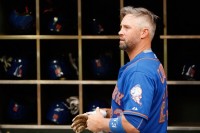
Last year, Michael Cuddyer was signed by the Mets to be that missing offensive piece. The Mets were so confident he would help them they were willing to forfeit their first round pick. It turns out they were wrong.
Cuddyer had the worst year of his career. He’s a career .277/.344/.461 hitter mostly playing in hitter’s parks like the Metrodome and Coors Field. Last year, he only hit .259/.309/.391. What was the reason for the decline? It could’ve been the switch to Citi Field. It could’ve been free agents the Mets sign always have a poor first year (see Beltran, Carlos and Granderson, Curtis). It could’ve been his turning 36. It could’ve been the injuries.
Cuddyer had a knee injury that compromised him for much of the year. He required surgery on his core. Either one of these injuries could reasonably explain the down year. At the very least, we can expect a healthier Cuddyer in 2016. With him being a bench player now, we can also expect a fresher Cuddyer too.
Mostly, you can expect Cuddyer to take some at bats against tough lefties with Granderson, Lucas Duda, and Michael Conforto. For his career, Cuddyer has hit .290/.377/.494. Even in a down year last year, he hit .273/.357/.343. These are good numbers against lefties. He’s important because the Mets best hitters are all lefties. This will help curb the effects of the Mets facing a tough lefty during the regular season.
Cuddyer’s other duties will include pinch hitting. For his career, Cuddyer has hit .355/.431/.548 in 72 pinch hitting attempts. Considering Cuddyer will be the team’s presumed top pinch hitter, these numbers are encouraging. Even more encouraging was his numbers as a pinch hitter last year. In 22 plate appearances, Cuddyer hit .316/.364/.316. Even in a down year, Cuddyer had good at bats as a pinch hitter.
Lastly, the Mets have a David Wright problem. Wright showed last year, he can still be an effective player. However, he can still only play only four days in a row. With Daniel Murphy, Juan Uribe, and Kelly Johnson being free agents, the Mets don’t have a definitive answer for Wright’s days off. Cuddyer has played some third in his career, but not with any regularity since 2005.
However, Cuddyer is now a bench player. He has to be ready to pinch hit and play multiple positions. If Cuddyer is even a hint of the player he once was, the Mets will have a strong bench in 2016. They will have an insurance policy for first, third, left, and right. Signing Cuddyer may have been a mistake, but it doesn’t mean he won’t be a useful player.
He’s going to have to play a big role in 2016, even if it’s a role neither he nor the Mets thought he would play.
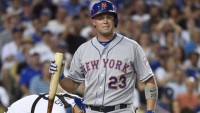
There are many thoughts about this offseason that baffles me. One is this notion that since the Mets offered Daniel Murphy a qualifying offer, it doesn’t matter if the Mets sign a player whose received a qualifying offer. The premise is the two moves cancel each other out.
For the uninitiated, the way the qualifying offer system works, if you sign a player who was offered a qualifying offer by another team, you forfeit your first round pick. In exchange, the team that lost a player has a pick tacked on to the end of the first round.
The only exception to this is if you have a Top 10 pick. In that instance, you forfeit your second round pick. The team losing the player still has a pick added to the end of the first round.
Right now, the Mets have the 24th pick in the 2016 draft. That pick will go higher if someone between 11-23 signs Murphy. In addition, the Mets will get another pick somewhere after the Cardinals and the start of the second round.
Now, I don’t buy the cancel each other nonsense. People are saying moving down a few slots is not a big deal. What’s the difference between picking 24th and say 33rd. That’s flawed thinking for a few reasons.
The first is their focus is misplaced. Say Murphy signs with the Rockies as reported. This means the Mets keep their 24th pick and receive the 31st pick (depending on how many teams lose a player in free agency and their W-L records). That’ll give you two picks in the top say 35. If the Mets forfeit their first round pick, their second pick will be in the 50’s to 60’s.
Now, draft picks aren’t a guarantee, but I’d assume that the player picked at 24 will be thought of as a better player than the player picked at 33 and the player picked 52. In addition, wouldn’t you rather have three picks in the top 60 as opposed to two?
This also brings me to my second point. The Mets farm system is decent, but it’s taken some hits lately:
- There was no 2015 first round pick due to the signing of Michael Cuddyer;
- Trading potential future ace Casey Meisner for Tyler Clippard; and
- Trading an even better pitcher in Michael Fulmer for Yoenis Cespedes.
In essence, the Mets could benefit from bringing in some more talented players. The idea here is to create a flow of prospects to the major league level. If you lose someone, you want to have a player waiting in the wings. If you need to make a trade, you want a well regarded prospect to make the trade you need to make.
Now, if the Mets feel they are one player away, sign that player. The goal is to win the World Series, and the Mets are so close. However, you have to be right. The Mets thought they were close to becoming a contender coming into the 2015 season, so they signed Cuddyer. Turns out they were right, but only after trading for Cespedes and calling up Noah Syndergaard and Michael Conforto.
Moral of the story is you have to be right otherwise you have a $12 million bench player instead of a first round pick who could’ve been a stud. Remember, prospects are always worth more than aging, expensive bench players. That’s why you don’t just sign someone with a qualifying offer attached to him.
You only sign that player if they’d be worth a big prospect because that’s what you’re doing.

Judging from what I’ve read, the Mets seem most interested in adding a CF in free agency. However, what I mostly see is the Mets are interested in lefty bats:
My sense of the free agent CF types who are on the Mets’ radar at this point: Span, Fowler, Parra.
— Marc Carig (@MarcCarig) November 6, 2015
Gerardo Parra, Denard Span, and Dexter Fowler are everyday players. They’ve been everyday players for several years. They’re expected to receive 3+ year contracts for $8 – 13.8 million a year. There should be a reasonable market for these players meaning they’ll have an option to go where they want to go.
This means they won’t go to the Mets, at least not as a platoon player. Therefore, if any of these players comes to the Mets it will mean they have assurances that they’ll be the everyday CF. They should make them the everyday CF if the Mets are going to spend what’s necessary to bring them into the fold.
So if the Mets sign a CF, it means the Mets have moved on from Juan Lagares. I’m not sure it’s a wise move. Not just yet (even if I think Fowler gives them the best chance to win). He’s a year removed from a Gold Glove season. He’s got an elbow injury that just requires rest. Isn’t it the best case scenario for everyone that Lagares is the everyday CF. After partly losing a World Series due to defense, why downgrade the place where you’re best defensively?
So, while I’m hopeful the Mets will make improvements, I’m not sure it’ll be in CF. This means Lagares will receive one last chance to be an everyday player. I hope he rewards the Mets for their confidence in him. Otherwise, the Mets will bring someone else to do the job.
This will be a big year for both the Mets and Lagares. I’m hoping Lagares will be a part of the Mets plans.
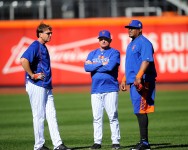
Unfortunately, after quite the colorful year, it seems that the Mets no longer have a spot for Juan Uribe on the roster. It’s a shame because he was a terrific locker room presence and leader. However, there may be a way to keep him around.
As Keith Law mentioned in his chat yesterday, the Mets could consider him as a bench coach. It’s possible the position will be open with Bob Geren interviewing for the Dodgers job. However, he’s not likely to get the job, and the Mets have invited the entire coaching staff to return. Furthermore, Uribe seems to love this game and may not want to retire.
He’s going to be 37 years old. This may be his last year in the majors. Although, I’m sure Uribe will force them to tear the uniform off his back. While his skills are diminishing, I’d like to see the Mets find a way to keep him. At the very least, they should offer him a minor league deal in the event he can’t get a major league deal elsewhere.
He has so much to contribute both this year and in the future. I hope the Mets find a way to keep him in the organization.
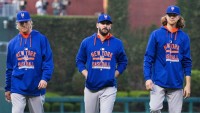
The Mets have some definite holes on their team. They did in 2015, but those holes didn’t prevent them from making the World Series. One of those holes continues to be the SS position. Unfortunately, the free agent market doesn’t appear to be a solution. That means you either roll with what you have or make a trade.
Now, everyone on the Mets roster can be traded except David Wright, who is a 5-and-10 player meaning the Mets can’t trade him without his permission. So other than him, any player on the roster is available for trade. No one is ever untouchable. Not even Noah Syndergaard. If the Angels call tomorrow and offer Mike Trout for him, you’re making the deal.
With that said, we’re pretty sure that is not going to happen. Funny thing is, I’m sure there are Mets fans who would object to such a trade. Overall, I’m not going to create trade rumors because you wind up sounding ridiculous. Sure, I’ll comment on rumors that exist as I’ve done in the past. However, it’s another thing to create them.
So I won’t be doing anything like suggesting the Mets trade Matt Harvey for Xander Bogaerts or Corey Seager. First, you’re assuming either team would do it. Second, you’re only creating the same unfillable SS hole on another team when there is decent to great starting pitchers on the free agent market. Seriously, are we to assume the Red Sox and Dodgers need to trade young SS because they can’t afford to pay Zack Greinke or David Price?
Furthermore, the Mets starting pitching is the reason the Mets were able to stay afloat. It’s the reason the Mets made it to and were competitive in the World Series. Great starting pitching covers up a lot. When you deal from a position of strength, you only serve to weaken yourself. So no, I don’t advocate trading the starting pitching.
I also don’t advocate creating rumors out of thin air.
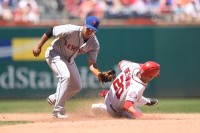
Last year, Terry Collins did a masterful job juggling the shortstop position between Wilmer Flores and Ruben Tejada. Looking over the free agent list, the Mets might be wise to go with Flores at SS next year.
The proverbial class of the SS market is Ian Desmond. He’s anticipated to receive a four year $60 million contract in free agency. He’s likely to receive and reject a qualifying offer meaning signing him comes with forfeiting your first round draft pick. The narrative is he’s coming off a down year. I’m not sure that’s true.
Yes, Desmond was not good in the first half hitting .211/.255/.334. He picked it up in the second half hitting .278/.310/.444. Overall, he finished 2015 hitting .233/.290/.384. In 2014, he hit .255/.313/.430. I could argue last year was just symbolic of a declining player as he hit .280/.331/.453 in 2013. For his career, he’s a .264/.312/.424 hitter. He’s hit .255/.329/.440 at Citi Field.
The thing is he’s going to have to hit to stay at SS. Last year, his UZR was -3.7 meaning he’s a below average SS. The prior year his UZR was 0.1 meaning he was average. Two years ago, his UZR was 4.4 meaning he was an above average SS. Again this is further evidence that Desmond is amidst a three year decline.
I can accept the argument that he had a down year last year due to his impending free agency. However, how do you explain his 2014? I’d rather take my chances with Flores, who is younger, has more potential, and surprisingly, is better defensively. The Mets have several areas to address, and they can’t wrap up all their money in a declining player.
There are ways to upgrade this team. Ian Desmond is not one of them.

Earlier, I had a case as to why I believed the Mets should try to re-sign Daniel Murphy. I think the Mets should bring him back. However, there are valid reasons why you don’t bring him back.
He’s not a good defensive second baseman, and that’s the only place to play him right now and in the near future. He’s prone to a base running gaffe or two. Re-signing him will be very expensive insurance option for David Wright, especially when you already have Wilmer Flores. You don’t want to create a log jam on the roster and in the infield for when Dilson Herrera is ready to play everyday in the majors.
Whatever the decision, I hope the process happens quickly. The longer it goes on, the more awkward it becomes for everyone. As a result, more questions get asked about why the Mets arent interested, or what’s wrong with Murphy that team’s aren’t interested? It’s better that the process happens quickly. The overall goal is to avoid the he said – she said that followed after Jose Reyes signed with the Marlins. The Mets were good to Murphy, and in return, Murphy was good to the Mets. There’s no need for anyone to look bad here.
As a parting gift, the Mets should get a first round compensation pick, and Murphy should get a huge contract.
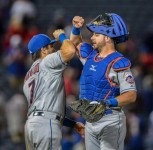
Growing up, watching those 80’s teams I remember going to a game or two when Gary Carter would get out from behind the plate and play on the field. It was a way to give him a day off while keeping his bat in the lineup.
I was thinking of that when I saw a report the Mets were not considering moving either Travis d’Arnaud or Kevin Plawecki out from behind the plate. Personally, I agree that they both help the Mets as catchers. d’Arnaud has hit well, especially for a catcher, while Plawecki has offensive potential. They are also excellent pitch framers. However, I still think it’s important d’Arnaud gets some work to let him play some games at third.
The Plawecki Reason
The first reason is Plawecki is still developing. You don’t want him languishing away on the bench as a backup for 162 game season.
Looking over the 2015 season, the catchers who caught most caught between 112 – 139 games this year. The average amount of games caught between them is about 125 games a season. This leaves Plawecki with only 37 games. If you could find another spot for d’Arnaud once a week, you could have Plawecki catch about two times per week. There’s 26 weeks in the MLB season. If Plawecki can play two games per well, that’ll get him an additional 15 games
It’s still not enough for a developing player, but it’s a lot better.
Injury Factor
d’Arnaud has been named the Mets 2014 and 2015 Opening Day catcher. He didn’t make it through either season without a trip to the DL.
In 2015, they were fluke injuries that landed him on the DL. One injury was a broken pinkie on a hit by pitch. The other was a strained elbow on a play at the plate. I don’t believe d’Arnaud is injury prone. However, it’s getting harder and harder to say that.
Truth is last year he had two separate DL stints costing him around 50 games. With a dismal Mets offense, they had to turn to Plawecki, especially with Anthony Recker and Johnny Monell doing nothing offensively. It’s that reason the Mets will use Plawecki as the backup next year. You don’t want to stunt Plawecki’s development, but d’Arnaud has a bat you don’t want to take out if the lineup.
The best solution is to allow d’Arnaud to play some games at another position to get him some at bats while letting him rest a bit by bit being behind the plate.
The David Wright Factor
Ultimately, I think the reason you let d’Arnaud play some third is because of David Wright. He can’t play more than four games in a row. Assuming he has to take off a game at least once a week, that’s 26 games. He still may need more than that as he re-adjusts to playing over 162 games.
When he returned, he had similar numbers to his whole career. Last year, he hit .289/.379/.434 (yes that includes the right games he played in April). For his career, he has hit .298/.377/.493. Sure, there’s less power, but he’s still a good hitter. It’s a bat they’ll miss when he’s not in the lineup. Right now, it seems the Mets have interest in bringing back Kelly Johnson as a utility player. Presumably, he will play the majority of games Wright doesn’t play.
Johnson is a career .251/.331/.424 hitter. Last year, he hit .250/.304/.414. d’Arnaud hit .268/.340/.485 last year. He’s a better hitter than Johnson. If you’re concerned about defense, Johnson isn’t exactly a Gold Glover. He’s average. There’s no reason d’Arnaud can’t be average out there with some work.
Overall
I think it would help d’Arnaud to stay healthy to get out from behind the plate. It would help Plawecki’s development to get some extra reps out there. It would help the Mets offense to have d’Arnaud’s bat out there when Wright can’t play. This move will help the Mets in 2016 and beyond.
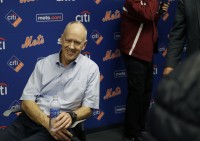
By any measure, the Mets had a pleasantly surprising run this year capturing the 2015 National League pennant. The 2015 Mets weren’t perfect. They had some holes to fill. On top of that, new holes were created by free agency. Can the Mets fill in those holes?
The answer to that question begins with another question – do the Mets actually have money to spend? There are reports out there that suggest they don’t despite the additional postseason revenue. There are various reasons why. However, as a Mets fan, all you care about is what can they spend. The answer may not be what you want to hear:
Alderson pegged this year's opening day payroll at $103M and said 2016's should be "somewhat" higher, with room to add at trade deadline.
— Mike Puma (@NYPost_Mets) November 4, 2015
Now, the Mets 2015 payroll was $120.4 million. However, a significant portion of that was covered by insurance due to David Wright‘s back injury. By my estimation, the Mets saved about $10 million. If we back that out, it means the Mets paid roughly $110.4 million in salary. Given Sandy Alderson’s statements that the Mets payroll will increase from the 2015 Opening Day payroll of $103 million, we should see the 2016 Opening Day payroll to be around the $110 million it was at the end of last year.
Right now, the Mets payroll obligations are estimated to be at $92 million for 25 players. Note, not all of these players will be on the Opening Day payroll due to various reasons from trades to the fact that the list has eight relievers on it. However, if the Mets keep all of these players, they’re paying them regardless if they’re playing in New York or Las Vegas.
In any event, that means the Mets have roughly $18 million to build the major league roster. That may be a problem because the Mets have question marks at 2B, SS, and/or CF. They also need a versatile player that is competent enough at third to play there semi-regularly. Effectively, this puts an end to my relatively modest Daniel Murphy–Dexter Fowler–Kelly Johnson plan.
That’s problematic because all three were expected to get somewhat reasonable deals Murphy and Fowler were only pegged to get four year deals. It’s not like the plan was Jayson Hayward and Zack Greinke. The plan was Murphy and Fowler. It’s absurd and depressing when you think about it.
It’s even worse when you consider an elite young starting rotation is slated to be paid a combined $7.1 million or $3.9 million less than what they paid for Bartolo Colon last year. It’s worse when you consider there’s no need for a bullpen upgrade.
Honestly, after seeing that comment from Sandy Alderson, I felt deflated a bit. After a pennant, the Mets will not be able to address their issues. It means if their cheap young pitching keeps them in it again, they’ll have to grossly overpay again at the trading deadline.
I’m sorry, but this isn’t how a pennant winner responds to falling just short. This isn’t how a New York team should operate, especially in an uncapped sport. There is no reason the Opening a Day payroll can’t be at least $120 million, which by the way, would’ve ranked them 15th, middle of the pack, last year.
Now, I truly can’t get upset until I see what the Mets do this offseason. They very we may spend more than they’re alluding. The payroll may not significantly rise, but they could pull off some shrewd trades to offset that. With that said, I’m not too enthusiastic at the moment.
We were promised if attendance went up the Mets would spend. Attendance went way up. It’s time for the Mets to finally spend some money.